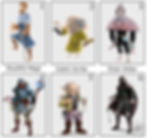No one plays alone. That's true for all board games. Yet we were surprised to learn that many (hobby) board game designers build alone or in small teams of two. Why is that, we wondered? Here is the answer we found...
Working as a Team: unique skills, powerful synergies
People come together to roll dice, play cards and move tokens across a board. Players compete, cheat, shout, laugh, have some drinks and snacks. That's the role model of any board game night as long as the world is not ending.
With this in mind, it came as a surprise to us that quite many (hobby) board game designer are working alone:
This quick Twitter survey with 83 votes is of course not representative. Still we kept wondering why so many people design alone or in groups of two. At BFF Games we are three quite different people with unique skills and passions:
One (M) is a product manager. He loves the business side of games and to tinker with details of the mechanism without ever growing tired.
Another (R) is an architect. He has a great eye for art work and design. When he is on fire, he creates sixteen different types of flags in one night.
The third one (A) is a trained historian. He loves stories and stays up until the sun rises for writing, world building and flooding Twitter with messages.
Having such diverse talents played out as a huge advantage for us. Yet lately we begin to see some difficulties with it.
Challenge #1: Deciding on Artwork
When designing a game, decisions need to be made. Small ones: "How many points is this character worth?" and big ones: "What artist do we hire for the game?" When you are designing a board game as a hobby, there is no boss to make the decision for you. Coming to good and quick agreements can be a challenging task.
In our team, we never established a formal decision making structure (let us know in case you did). Instead, we relied on well reasoned arguments and over 20 years of friendship.

Some Artwork that made it into our final. Links to the artists bellow.
Still, building a game is also an emotional thing. People are emotionally attached to the characters, mechanisms, stories and ideas they contribute. We noticed this strongly when deciding on artwork. Originally we intended to go with epic fantasy art. This was M's passion, however it was far too heavy for our light game. We strayed into comic art, because A likes a good laugh as much as a good game. However, the artwork we found was far from unique. R likes artwork that is edgy and outstanding, but often not affordable. So whatever art we are going to pick someone will be a little dissatisfied.
Challenge #2: Different Goals
Artwork aside, a much harder conflict came up recently: We noticed, we do not follow the same goal. We really thought we were in the clear with this one. After all, each and everyone one of us wants to make a 30-minute fantasy card game with deduction elements. That's a clear goal, right? Yet when a discussion came up to change the setting of the game along with the artwork, it became absolutely clear that we had two very different interpretations of that goal:
We want to make a 30-minute card game set in our fantasy world
We want to make a 30-minute card game that is successful on Kickstarter
I think you can easily imagine the lines of conflict here. What is more important: Our personal setting or the games success? A hard question! We discussed it for several nights. By now, the discussion has ceased. The train is moving again. Yet still we are wondering: Is this why so many people build board games alone?
We'd love to hear your experiences!
Markus, Raphael & Andreas
Commissioned Artists:
1, 2, 3: Kenje123
4, 5, 6: Abhimanyu Agastya
We commissioned these and more artists via Fiverr. If you use this promo link to sign-up, you get a 20% discount on your first order and we a small voucher for more art. Thank you for using it!

